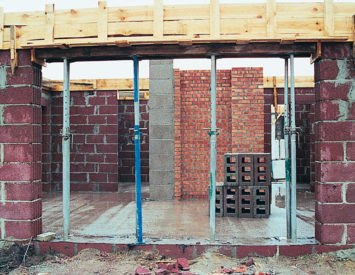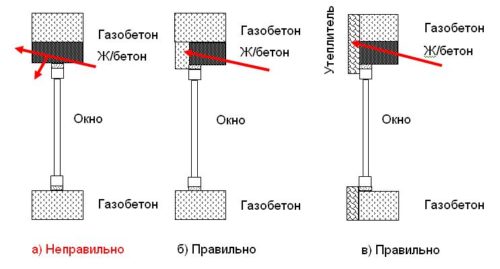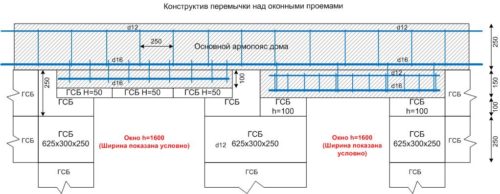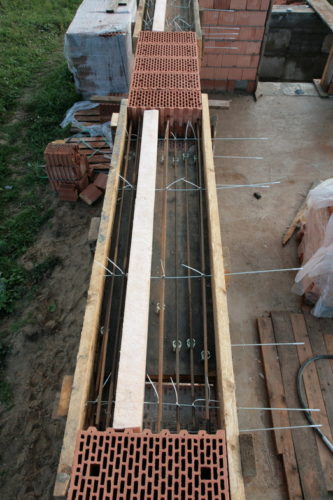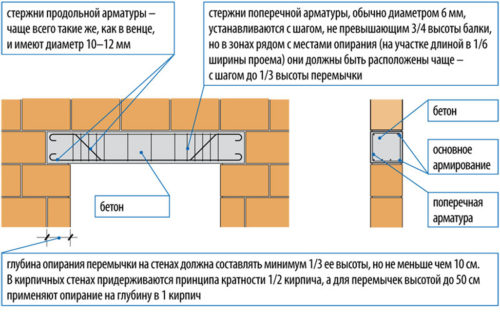If you independently built your own home, then I have been faced with the issue of arranging the door or window passage. For these parts of the building, it is necessary to install special support parts that will become a reliable basis for further masonry or filling with concrete. As a strengthen, special jumpers are used, which are installed above window and door peters. There are already ready-made structures that can be purchased at the reinforced concrete shop. In this case, the product will be more expensive than self-made design, besides, it will also require additional costs associated with the delivery of the jumper. To save a little, it is better to do all the work on the installation of the jumper of the window loop yourself.
Content
- Types of jumpers over window and doorways
- Rules for creating jumpers over window and doorways
- Jumper over window and doorways do it yourself. Tools and materials
- Manufacturing and installation of formwork for jumper door carriage
- Warming of the jumper of the window opening
- Pouring and reinforcement of the jumper
Types of jumpers over window and doorways
Before getting to work, I would like to draw your attention to some of the features of such a product. The use of one or another jumper depends on the type of design and the alleged loads.
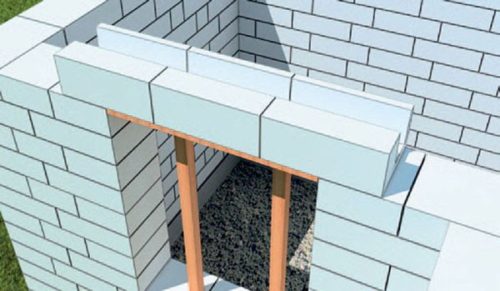
For different types of structures use the following types of jumpers:
- rigel (jumper of a large size. Special shelf located in its upper part is used as a support of the design);
- run (large jumper used as carrier);
- pencil (type of jumpers that do not play a carrier role. Look like thin designs (hence the name), which are often equipped with door loops);
- carriers (such structures take on all load from the slab of the overlap);
- undesome (jumpers, designed for the load from the masonry above the window or door loop).
For the arrangement of the passage in his own house, it is enough to mount an undesiable jumper. In case the building is more than 2 floors with a height, you can set the carrying type of construction. In addition, you can mount the metal jumper, or collect it above the drive out of the brick. But we still believe that the most optimally and appropriate is to collect a delicate jumper from reinforced concrete with their own hands. Thus, you will receive a high-quality product that will not yield in its characteristics of finished products, but it will be cheaper.
Rules for creating jumpers over window and doorways
The process of manufacturing jumpers from reinforced concrete at first glance may seem fairly simple. To properly install such a design, you need to know some nuances that will help to spend all the work qualitatively.
By mounting the reinforced concrete jumper, pay attention to some subtleties of technology, among which the following can be distinguished:
- the height of the concrete jumper is not more than 0.05 on the length of the door or window loop;
- the width of the jumper should be equal to the width of the wall;
- as a reinforce, it is better to use a metal corrugated rod with a diameter of at least 14 mm;
- formwork and backups are removed only 20-30 days after the fill. This is necessary so that concrete is completely discussed;
- choosing a finished jumper, do not forget to tell the seller about the alleged loads and other features of your home;
- so that in the process of masonry does not occur the drops, it is better to pour a jumper with a solution at the moment when its upper part will be in the same plane with the last layer of brick, aerated concrete, seven, etc.;
- in the process of filling the solution, use a deep vibrator. This will help to avoid emptiness in the design;
- to create jumpers in carrying walls, use high-quality grave concrete.
If you are going to do everything yourself, then definitely pay attention to each of the above councils, then the installation of jumpers over the doorway will seem not so difficult to you.
Jumper over window and doorways do it yourself. Tools and materials
To get a quality product, you need to use only the right material. In addition, it would be nice to acquire all the necessary tool, then the work will pass faster.
For high-quality assembly and installation of reinforced concrete design, the following will be required:
- concrete mixer, deep vibrator, Bulgarian, electrolovik, screwdriver;
- hammer, knitting hook, mount, trowel, vest, shovels;
- roulette, level, stepladder, gloves, overalls;
- edged board with a thickness of at least 20 mm, timber;
- renormal corrugated rod with a diameter of at least 14 mm, knitting wire, metal corner, rolling 6-8 mm;
- galvanized nails 80-100 mm with a wide hat, wood screws, polyethylene film;
- studs, nuts, washers, mounting foam;
- sea sand, cement M500, small gravel, plasticizer, insulation.
In addition to the above, we advise you to conquer in advance, and find an assistant. Since the work will be partly at the height, then the additional pair of hands does not prevent you.
Manufacturing and installation of formwork for jumper door carriage
In order to make a concrete jumper in accordance with all the rules, it is necessary to assemble the framework of the future design. This will require several boards and a bar that are locked in shields. The shields are located below and from both sides in the form of an inverted letter "P". At the same time, the lower shield in length should exactly coincide with the width of the day.
In the formwork, it is better to drill holes in advance. This will help subsequently fasten the shields on knitting wire. The inner part of each shield is trimmed with a polyethylene film so that the solution in the fill process does not flip into the slot between the boards. When the shields are collected, you can proceed to the immediate assembly of formwork.
By mounting the box for the future jumper, come as follows, acting in the stages:
- Start from installing the bottom shield. Note that it should correspond to the size of the length and width of the day. From the floor to the outer part of the lower shield, the backups of the required length are exhibited. In order to accurately set the shield to the horizon, use the construction level.
- Now you can mount side shields. At first, the shield is fixed to the wall on the self-tapping screw or nails (depending on the type of coating). After that, the shield can be mounted to the bottom.
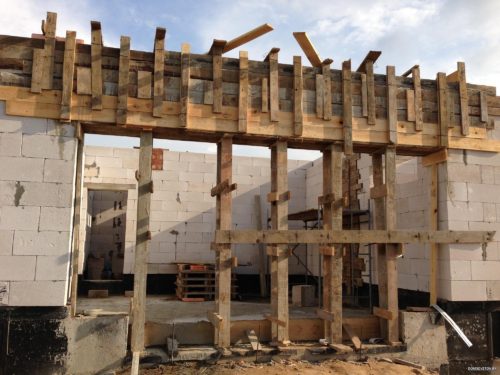
- In a similar sequence, the second shield of formwork is installed. Between them, it is better to fasten with wood self-draws.
- To under the severity of the solution, the side shields are not collapsed, they must be reliably fixed. To do this, you can through pre-drilled holes to stretch the knitted wire with a double ring. After that, take a small piece of reinforcement, and begin to pull the wire. You can also take advantage of the hairpin, which has been done through both shields, which is fixed from the outer part to a wide flat washer with a nut of the desired diameter.
After the box is assembled and installed, it is checked for the presence of cracks. If there are such, they can be built by mounting foam. Make sure once again in accuracy of vertical and horizontal levels. The distance between the inner edges of the side shields must match the width of the day.
Warming of the jumper of the window opening
The insulation layer must be set so that on one side it adjoins the jumper, and on the other to the masonry. To do this, use minvatu with a thickness of at least 50 mm, however, this is not the best option. In the future, installing the window, you will have to put the slopes with brick. Since mineral wool with foam has a rather low level of adhesion, the window frame will not be fixed properly.
We advise you to use extruded polystyrene foam as insulation. Such a material is much more dense of mineral wool. The sheets with a thickness of at least 30 mm are excellent. If you decide to use this insulation, then you will note that the gap between it and the window frame will be subsequently bleed by mounting foam. In this case, you do not have to warm the slopes.
Pouring and reinforcement of the jumper
Before starting concrete work, it is necessary to calculate the amount of material for the pouring of the jumper over the opening. For this, it is sufficient to multiply the length, width and height, having previously measured all the indicators using a roulette. Note that all measurements must be made from the inner walls of the shield. When calculating, do not forget about the presence of insulation inside the box.
To correctly pour the reinforced concrete jumper, you need to do the following:
- On the bottom of the formwork laid several brick trimming with a height of about 30-50 mm. They will subsequently laid the design from the reinforcement.
- We start collecting a metal frame. The reinforcement rods with a diameter of 14 mm will be laid along. The wire rolling wire with a diameter of 6 mm is suitable as transverse nodes.
- The frame is placed in the formwork. Remember that it should not be located directly on the surface of the shield. Place the frame on brick trimming.
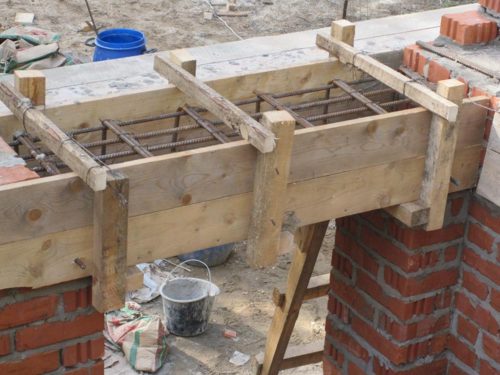
- To fix the frame inside the formwork, you can release a slightly transverse rod through the side shields. Subsequently, repellent parts of the reinforcement can be trimmed with a grinder.
- Now it is necessary to prepare a solution to the fill. To make a high-quality concrete from cement, sand and fine rubble, use the following ratio: 1/2/5, respectively.
- The mixture is gained in the vest, after which they begin to sequentially distribute inside the formwork. It is better to pour everything, moving as if layers than immediately pour the whole solution. This will help avoid deformation of the formwork.
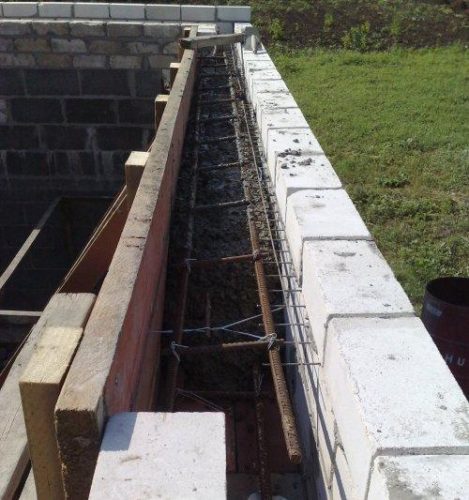
- Do not forget to use the deep vibrator. It will help remove bubble formations from solution.
- Now concrete needs to give time to hardened. It will take it from 20-30 days, depending on weather conditions. In the event that rain begin, the non-agricultural solution is better to hide the film from above. When you work on a hot, a concrete surface can be mixed with water.
- Remove the formwork by mounting. If the jumper is located in the gasline wall, it is enough to unscrew the screws, then dismantle the shields. Lastly, the bottom shield and backups are removed.
Professional advice: collecting the frame from fittings, do not use welding. The branches must be connected strictly with the help of knitting wire. This design will be more reliable.
As we can see, make a jumper over the door or window opening personally - quite real. It is enough just to know the basic rules of work with reinforced concrete structures. Hold the choice of material for the metal frame and formwork special attention. Do not forget also that the concrete must fully operate before starting to remove the formwork. Do everything consistently, then you will have an excellent concrete product that will not give up the quality of an expensive finished analogue.
To better figure out the process of making window and door jumpers from reinforced concrete, we advise you to see the following video:
